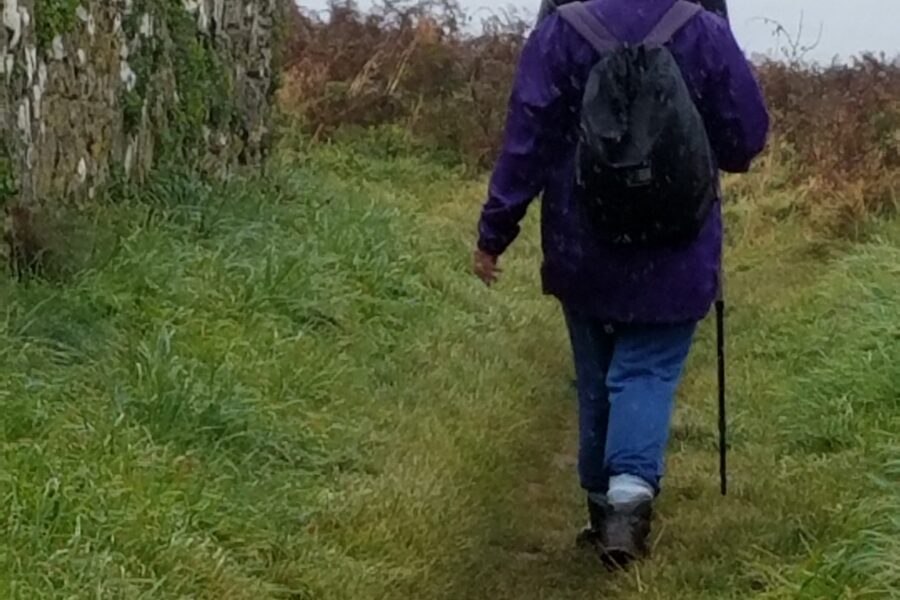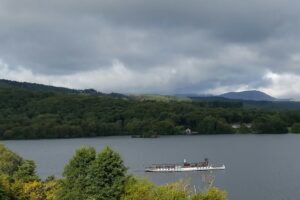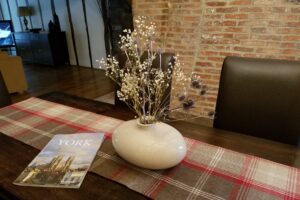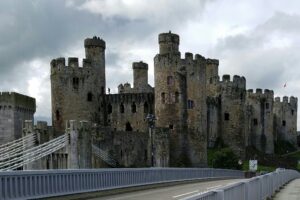After a dose of the BBC and coffee, I return upstairs and survey what is hanging in my closet. My clothing choices aren’t vast but I pick out the warmest of what is available. I don my raincoat and scrunch my hair under a brown wool cap.
Turning left out our back door, we walk through the stable arch and cross the courtyard. Our instructions saying to gather at the reception center for our coastal walk, which includes lunch at the Lobster Pot in Marloe. Even though the forecast is not a namby-pamby—maybe it will rain—but a firm statement of 100% chance of rain, there are twenty brave souls ready for adventure. Clustered in a tight group, they are telling the receptionist what they would like her to order for their lunch. Our choices are stuffed baguettes or stuffed jacket potatoes. I choose a tuna baguette, Michael requests shrimp.
Of course, all of the talk is about the weather and what will happen. Everyone but me checks their phones for radar updates. Things don’t look good, but there is a chance that in thirty minutes things will turn around. Two not so intrepid adventurers drop out, then two more, then another two. As the remainder of the group walk toward the sitting area to receive an orientation from our almost ninety-year-old guide, Margaret, we lose four more who opt for the warmth of their apartments.

Margaret is disappointed that so many are afraid of the rain. “If you live in Wales, you live with the rain,” she tells everyone. As she continues to talk the receptionist calls out, “The Lobster Pot is closed. They say their Internet is out which means their cash till won’t work.” Lunch is apparently—out.
Margaret grumbles and asks whatever happened to doing sums in your head. As she continues her talk, the receptionist calls out that it is now raining buckets. “I really think you should cancel the walk Margaret,” she says apprehensively.
Margaret says, “We’ll give it ten more minutes.” And because she wills it, after ten minutes the rain lets up. We gather our things, ready to start on a shortened version of the planned four-and-half hour coastal path hike. Before we are out the door we lose four more of the group. For some reason the two Texans, who know nothing of walking in cold wet rain on slippery paths, remain standing—refusing to be quitters; Michael, because that is who he is, and me because I am married to Michael.

Walking down the long drive away from the castle it really isn’t so bad. The skies barely drip, not pour, and the water beads up on my new black raincoat. I don’t even use my umbrella—Michael and I are the only two out of the six remaining adventurers that even carry one. Our guide Margaret sure doesn’t have one, and her much younger assistant (also named Margaret) Margaret-2 doesn’t either. Our tender-footedness is showing.


We walk over a sheep guard that is so wide a child’s foot could easily slip through the cracks. Then the road narrows and we finally turn onto a leaf-strewn path that ventures into the woods. All the while Margaret talks and teaches. We stop at an ancient garden wall attached to an ancient ruin. Margaret calls it the abbey, but when we tour the pump house and read the signs, they say there is no proof that an abbey ever stood here. I am reminded of the Druids—I’ve been reading a book—who left no tangible proof of their existence. In their case, it was a matter of he said, she said, he said; names too foreign to remember except for Caesar’s.




Finally, we enter the Norman Parish Church of St. Brides’s while Margaret tells us, “This is one church that will never close because it is a tourist church.” To visit? An attraction? To attend services? I don’t get an explanation. I can’t help but wonder.
Stepping out of the miniature church and walking through its small courtyard, we immediately reach the coastal path—but not without losing two more of our small group. The remnants of our tattered and torn group—four tourists and two guides—begin walking up the muddy, slippery trail.






At the tail end of our merry little band, I follow behind Margaret-2 envying her walking stick and shoes with treads as deep as tires. She apologizes for the fact that we are continuing our walk and not returning to the castle. “Margaret wants to visit her husband,” she informs me, “He died last year and she spread his ashes on the cliff up the hill, around the corner.” With this bit of information, there is no way I won’t continue following Margaret to wherever she wants to go.


Suddenly the wind picks up and the rain turns halfway serious. We are forced to retreat, returning the way we came until luckily we approach a shortcut through the meadow up to the castle. Walking as fast as we are able, our heads bent into the wind, I give up on my umbrella. I look back at Michael, he uses his as a shield, holding it out in front of him as he too fights the cold wet blustery weather. Because of the hood on the raincoat I’m wearing my head remains somewhat dry, but my black pants are soaked through in the front and my raincoat begins to retain the water that once beaded on its surface. All six of us look like drowned rats as we struggle up the hill.
Finally sheltered in the warmth of our cottage we shed our wet clothes in the kitchen and then run upstairs looking for something warm and dry. With our wet clothes and shoes spread over the radiators throughout the apartment and a hot cup of tea warming my hands, Michael looks at me and says, “Well, that was fun.”
Saint Brides – The Abbey
…Gateway and walled gardens of the largely demolished original gentry house at St Brides, erroneously called The Abbey. First recorded as `le Hill’ in 1298 the house belonged to the de St Bride family, and then in the late C15 passed to the Laugharne family. John Laugharne died in 1715, his heiress marrying William Philipps of Sandyhaven who may have built the new house on the site of the present St Brides Castle in the 1730s. It was one of the larger houses of Pembrokeshire in the C17, having 11 hearths in 1670. Fenton in 1811 thought that the old house had been quadrangular, enclosed by a high battlemented wall with wall-walk and arched gateways to front and side. These gateways survive, of the house itself a ruined one-room section of some two and a half storeys remains without dateable features. The gateways may be C16 or early C17.
Later in our stay we attend a Welsh Night, where we learn more stories about the St. Brides and the (Lucky) Laugharnes which have the potential of stories for the big screen. i.e, a beautiful young girl (St. Brides family) rescuing an almost dead shipwrecked sailor and later two of their descendants drawing lots with another prisoner seeing which one would be hanged for treason and which two would go free.









2 Comments
Leave your reply.